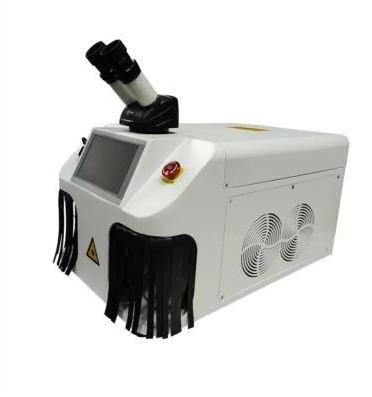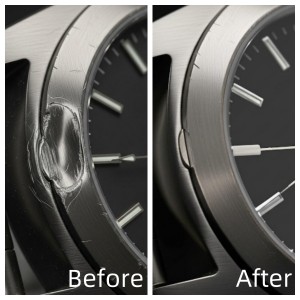A deep scratch on a cherished luxury watch once meant permanent damage. For decades, the only solution was aggressive polishing—a “subtractive” process that grinds away a watch’s original metal. This method softens the sharp, defining lines and chamfers, diminishing the watch’s character with each polish.
Today, laser welder offers an advanced “additive” technique. Instead of removing metal, we add it back. Using a focused laser and a perfectly matched filler wire, a skilled technician can rebuild the damaged area. This modern luxury watch repair restores a timepiece to its original factory specifications without compromising its shape or integrity, making damage once considered permanent reversible.
How Does Laser Watch Welding Work?
So, how does this magic beam of light actually perform watch case repair? It’s a meticulous process that combines cutting-edge technology with old-world craftsmanship. Think of it as a two-part masterpiece.
Part 1: The Technology—Additive Watch Repair
The first step is adding the metal back. A highly trained technician looks through a powerful microscope, guiding a laser with incredible precision.
A very thin wire of matching metal is introduced to the damaged spot. The laser fires in short, controlled bursts, melting the wire and fusing it directly into the scratch or dent.
This isn’t a quick fix. Rebuilding a worn-down lug or a deep gouge can take tens of thousands of individual laser “shots” to ensure a perfect, seamless bond.
Part 2: The Artistry—The Crucial Refinishing
Adding the metal is only half the battle. The true mastery in watch restoration is in what comes next: the finishing.
Once the new metal is in place, it’s a rough patch that stands proud of the surface. Skilled artisans then take over. They use a combination of hand files, lapping machines, and specialized polishing tools. Their goal is to carefully shape the newly added metal, perfectly recreating the watch’s original sharp lines, crisp bevels, and complex finishes—like the distinct transition from a brushed to a polished surface. This is where technology meets art.
Top 3 Benefits: Laser Welding vs. Polishing
Why is laser welding so superior to old-school methods like polishing or soldering? Let’s break it down.
1.It Reverses Damage, It Doesn’t Just Hide It
This is the core concept of additive vs. subtractive repair. Polishing thins out a watch case, permanently altering its geometry. Laser welding rebuilds it, preserving the watch’s intended dimensions, weight, and, most importantly, its value.
2.Unmatched Precision and Safety
A laser creates a “minimal heat-affected zone” (HAZ). This means the heat is incredibly localized and doesn’t spread. Why does that matter? It means there’s virtually no risk of damaging nearby heat-sensitive parts like movement components, crystals, or gaskets. This precision is impossible with a traditional soldering torch.
3.A Stronger, Seamless Repair
The integrity of a laser-welded repair comes from its process. It melts and fuses the metals into a single, continuous piece, creating a true molecular bond. This is fundamentally different from a solder joint, which acts more like a metallic adhesive. The resulting weld is exceptionally durable, with a strength that is comparable to the original case material. This creates a structurally sound and seamless repair with no risk of discoloration or weakness over time.
What Can Be Fixed? Common Laser Welding Applications
The versatility of laser welding means a wide range of common and complex issues on your timepiece can be addressed with unparalleled precision.
Common Applications Include:
Case and Lug Restoration: Repair over-polished lugs, fill deep dings on watch cases (e.g., Rolex, Omega), and restore sharp, factory-original chamfers.
Bracelet and Clasp Repair: Provide solutions for valuable vintage bracelets by rebuilding worn links to tighten stretched bands (like the Rolex Jubilee). Easily repair broken links and worn clasp mechanisms.
Bezel and Crown Repair: Offer intricate repairs by meticulously filling dents and scratches on fixed metal bezels, winding crowns, and other small components before refinishing.
Considerations and Limitations of Laser Welding
Laser welding is an incredible advancement in watch restoration, but it’s not a one-size-fits-all solution. Making an informed decision requires a deeper understanding of both the technical boundaries of the process it raises for collectors.
Technical Boundaries: What Laser Welding Can and Cannot Do
While the technology is precise, its application has clear limits defined by the type of damage and the material involved.
Where it Excels: The process is ideal for additive repairs on static components. Think of it as meticulously filling a cavity. It’s perfect for reversing deep scratches, rebuilding the sharp edges of worn-down lugs, correcting dents on a case side, and fixing bracelet links. The primary goal is to restore the original geometry and sharp lines of the watch without removing precious metal.
Where it Falls Short: Laser welding cannot resolve issues of catastrophic structural failure. For example, a case that is cracked all the way through has lost its fundamental integrity. While a laser could potentially seal the crack cosmetically, it wouldn’t restore the tensile strength required to guarantee water resistance or protect the delicate movement from shock. Furthermore, the success of the repair is heavily dependent on the filler material. A perfect, invisible weld requires an exact alloy match, which is straightforward for common stainless steels and golds but can be challenging for more exotic or proprietary metals.
A Note on Cost: As a highly specialized service requiring advanced technology and skilled technicians, laser watch welding represents a premium repair solution. While it is an investment, it is one that ultimately serves to preserve the long-term value, integrity, and aesthetic of your cherished timepiece far beyond the capabilities of traditional methods.
Final Thoughts: A Considered Choice for Preservation
Ultimately, choosing to have a watch laser welded is more than just a repair—it’s a decision about preservation. It involves weighing the desire for cosmetic perfection against the value of historical character.
It’s a stunning marriage of modern technology and timeless craftsmanship that, when applied thoughtfully, allows us to save watches that were once considered lost causes. It preserves not just the metal, but the history and sentiment attached to these beautiful machines. In the world of horology, laser welding has redefined what is possible. It seamlessly transforms once-permanent flaws into invisible mends, preserving the intended artistry of fine timepieces for the future.
Post time: Aug-22-2025











